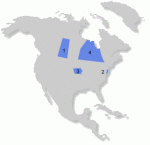First occurrence of BVD forms
1 “X Disease” 1946 (Saskatchewan, Canada); 2 Viral Diarrhoea 1946 (New York, USA); 3 Mucosal Disease 1953 (Iowa, USA); 4 Severe Acute BVD 1993 (Ontario, Canada)
The beginnings as of 1946
The disease complex of BVD/MD looks back on a short (compared to some other viral diseases) but busy history. Two authors first described the disease in 1946. One of them, Childs, referred to the outbreak of a cattle illness in Saskatchewan, Canada, which attracted a great deal of attention by an intermittent occurrence with low morbidity but high lethality. Affected cattle displayed watery bloody diarrhoea, mucous membrane erosions, fever and other (from today's perspective) typical BVD-symptoms [1].
In the same year, Peter Olafson et al. of Cornell University described a similar outbreak in the state of New York/USA. Olafson recognized a respiratory component, leucopenia, a lower milk yield and an increased abortion rate [2]. The disease was reproducible, however, no bacteria could be isolated; hence Olafson suspected a viral etiology and introduced the name of "virus diarrhoea" (VD). He drew the distinction between virus diarrhoea and X Disease, the latter of which was mainly characterized by hyperkeratosis and caused by ingestion of toxic substances (Naphtalenes).
The fifties
In the fifties, a special form of virus diarrhoea was reported for the first time in Iowa/USA. It was called Mucosal Disease. The main symptoms of this new illness were haemorrhages and intestinal erosions [03]. Unlike virus diarrhoea, however, MD couldn't be triggered experimentally. One therefore assumed, that virus diarrhoea and Mucosal Disease were two different diseases. In 1957, scientists isolated a cytopathic (cp) virus from an MD case [04], an experimental reproduction of the illness, however, could still not be achieved. In the same year researchers at Cornell University managed to isolate a non cytopathic (ncp) virus from a VD case [05]. At that time, the connection between the two illnesses was not known.
The sixties and seventies
In 1960 researchers at Cornell University isolated a cp virus from a VD case (it was called Oregon C24V) [06]. After artificial inoculation, the virus triggered typical symptoms of virus diarrhoea and led to the production of antibodies, which neutralized both cp and ncp VD-Viruses. Physical and antigenic examinations indicated that VD viruses and MD viruses had a lot in common; and both of them were closely related to classical swine fever (at that time called hog cholera) virus.
In 1961, Oregon C24V was modified in a way, that it could be used as the first vaccine against virus diarrhoea (it caused seroconversion without clinical symptoms) [07]. Unfortunately, the Oregon C24V vaccine caused a variety of adverse side effects (MD triggering, fertility disorders, congenital defects).
Due to the similar pathology of both VD and MD as well as the antibodies' astonishing cross reactivity against the two pathogens, VD and MD were soon considered to be one disease complex, despite their unequal epidemiology (VD occurred sporadically with high morbidity and low lethality in all age groups, whereas MD occurred primarily in young animals, with low morbidity, but high lethality; moreover, VD was, in contrast to MD, experimentally reproducible). At the end oft the sixties, the disease complex was commonly called BVD-MD.
The research activity during the 60s and 70s concentrated primarily on experimental infections, particularly during gestation and in newborn calves. It became evident that BVD-MD could produce abortions, birth defects and live weak calves. "Chronic MD" was due to an intrauterine infection with ncp BVD-MD virus, affected calves were persistently infected and displayed an astonishing immunological peculiarity: they were unable to produce antibodies against the BVD-MD virus [08].
The eighties and nineties
In 1984, Brownlie et al. reproduced MD experimentally by inoculation of cp virus (which was antigenetically homologous to the ncp virus causing the persistent infection). The experiment indicated that a combination of both biotypes was able to produce substantially heavier symptoms than either one of them alone. At the end of the 80's, BVD MD virus was identified as a Pestivirus and assigned, together with Classical Swine Fever virus and Border Disease virus, to the Family of Togaviruses (see below!).
It was not until the late eighties, when the first cases of BVD Haemorrhagic Syndrome occurred, that the public opinion suddenly changed and acknowledged, that ncp BVDV can indeed cause serious sickness in cattle. This severe form of BVD was accompanied by fever and thrombocytopenia (this caused bloody diarrhoea, epistaxis as well as petechial and ecchymotic bleedings on mucous membranes). The differences between BVD and MD became increasingly vague. Ever since, the characterization of BVDV at an immunological, molecular and genetic level has been propelled vigorously. In 1991 the BVDV was reassigned to Flaviviridae family. In the course of the examination of "BVD Haemorrhagic Syndrome" and "Severe Acute BVD" (registered for the first time in 1993 in Canada [12]), for example, BVD (geno-)type 2 was identified [13]. Till this day, however, the exact pathogenetic mechanism of BVD/MD is not entirely known.
Milestones in BVD-Research
| Year | Event |
| 1946 | Childs describes X Disease [01] Olafson describes virus diarrhoea in cattle [02] |
| 1953 | Ramsey/Chivers describe Mucosal Disease [03] |
| 1957 | Isolation of a cytopathic virus from an MD-patient [04] Isolation of a non-cytopathic virus from a VD-patient [05] |
| 1960 | Isolation of a cp virus from a VD-patient [06] |
| 1961 | First-time application of a VD-vaccine (Oregon C24V, live vaccine) [07] |
| 1973 | Discovery of immunotolerance in persistently infected animals [08] |
| 1984 | First-time experimental reproduction of MD [09] |
| 1988 | Genomic sequence of BVDV published [10] |
| 1991 | Pestiviruses are assigned to the family of Flaviviridae [11] |
| 1993 | First occurrence of “severe acute BVD” [12] |
| 1994 | Identification of genotype 2 [13] |
